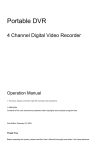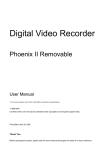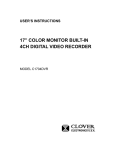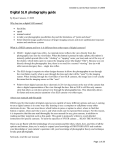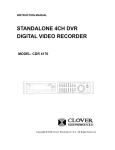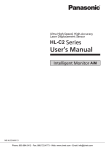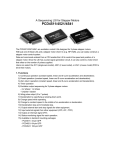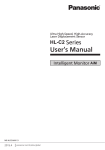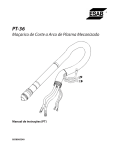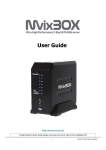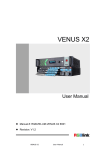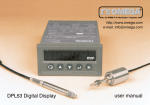Download User Manual
Transcript
User Manual The picture, diagram and function might differ according to the specifications. ©1997-2004 Contents of this user manual are protected under copyrights and computer program laws. Thank You Before operating the system, please read this User’s Manual thoroughly and retain it for future reference. 2 / 49 Important Safeguards and Cautions The information in this manual is believed to be accurate as of the date of publication. Our company is not responsible for any problems resulting from the use thereof. The information contained herein is subject to change without notice. Revisions or new editions to this publication may be issued to incorporate such changes. Important Safeguards Warning 1. Use the adaptor, which is supplied or recommended by the supplier. It may cause fire. 2. Do not dismantle or assemble the product. It may cause malfunction or fire. 3. Do not touch the product with wet hands. It may cause malfunction or fire. 4. Matters must be ensured to a professional for product installation. It may cause malfunction, electric shock or fire. 5. Consult the place of purchase if the need for installation arises. Delinquent installation may be the reason for malfunction, electric shock or fire. 6. Ground applies to video products equipped with a 3-wire grounding type plug having a third (grounding) pin. This plug only fits into a grounding-type power outlet. If grounding is not done, it may cause malfunction or electric shock. 7. Ground connection must not touch gas pipe, water pipe or telephone line. If grounding is not done properly, it may cause electric shock. 8. Prevent metallic foreign substance from going inside the product. It may cause malfunction or electric shock. 9. Do not spray insecticide or flammable spray while driving. It may cause fire. 10. Prevent water from entering inside electrical parts. Clean with a dry towel or malfunction or electric shock could result. Caution 1. Use the power cord, which is supplied or recommended by the supplier. The internal fan rotates at high speed and may cause an accident. 2. Do not drop, give strong vibration, or shock to the product. It may cause malfunction. 3. The air inhaler on each sides and the fan of the back panel must not be blocked during installation. The internal temperature of the product would be greater than allowable and could cause malfunction or fire. 4. Do not touch the product or the power cord when there is thunder. It may cause electric shock. 5. Do not install the product near or on top of heating source. The internal temperature would be greater than allowable and could cause malfunction or fire. 6. Do not install the product on inclined or unstable location or where vibration could be committed. It may cause malfunction. 3 / 49 Cautions about the Power Warning 1. Must use the outlet of the grounding to connect the power cord. It may cause fire. 2. Do not connect on the middle of power cord or use extension cord. It may generate heat or cause fire. 3. Do not touch the power cord with wet hands. It may cause electric shock. 4. Keep power cord dry and protect from humidity. It may generate heat or cause fire. The power cord is not waterproof. 5. Hold the body of the plug while removing the power plug. Do not pull the power cord. Damage to the power cord may generate heat or cause fire. 6. Check the power plug regularly. Humidity and moderation in smoking may cause fire. 7. Remove power cord from outlet when product is not used for a long time. It may cause a short-circuit or electric shock. Caution 1. Do not turn off the power by removal of the power plug. To turn off the power, click the power button from the back panel. 2. Do not cut off the power artificially, or give shock or vibration to unit while the hard disk is activating. It may cause hard disk failure or loss of data. 4 / 49 CONTENTS: 1. SYSTEM STRUCTURE 1.1 CHECK THE CONTENTS OF THE BOX 2. SYSTEM CONFIGURATION 7 7 8 2.1 FRONT PANEL 8 2.2 REAR PANEL 10 3. INSTALLATION 11 3.1 CONNECTING PERIPHERAL DEVICES 11 3.1.1 CAMERA INPUT 12 3.1.2 MONITOR OUT 12 3.1.3 SVHS OUTPUT 12 3.1.4 SERIAL PORT 12 3.1.5 ETHERNET 10/100 12 3.1.6 ALARM & RELAY 12 3.1.8 AUDIO INPUT AND OUTPUT 12 3.1.9 POWER INPUT 12 4. HDD INSTALLATION 13 4.1 INSTALLING NEW HDD 13 5. STANDARD OPERATION 15 1. SYSTEM STARTUP AND SHUTDOWN 15 1.1 SYSTEM STARTUP 15 1.2 SYSTEM SHUTDOWN 16 1.3 COUNTERMEASURES AFTER ABNORMAL SHUTDOWN 16 2. REAR TIME LIVE MODE 16 2.1 SCREEN CONFIGURATION 16 2.2 SINGLE SCREEN MODE 17 3. NAVIGATING AND SELECTING MENU 18 4. PLAYBACK 18 6. MENU SETUP 20 5 / 49 1. MENU TREE 20 2. PASSWORD SETUP 22 2.1 BASIC PASSWORD 22 2.2 ADVANCED PASSWORD 23 3. TIME SETUP 24 4. LANGUAGE SETUP 24 5. RECORD SETUP 25 5.1 OVERWRITE 25 5.2 RECORD ON/OFF 25 5.3 COLOR MODE 25 5.4 RECORD QUALITY 25 5.5 IDSM QUALITY 26 5.6 MOTION SENSITIVITY 27 5.7 RECORD SPEED 27 5.8 RECORD SCHEDULE 28 6. VOICE SETUP (OPTION) 29 6.6.1 VOICE RECORD 29 6.6.2 VOICE CHANNEL 29 6.6.3 VOICE VOLUME 29 6. CAMERA SETUP 30 6.1 CAMERA TITLES 30 6.2 BRIGHTNESS 30 6.3 CONTRAST 30 7. ALARM SETUP 31 7.1 ALARM ON/ OFF 31 7.2 ALARM ATTRIBUTE 31 7.3 VD LOSS ALARM 32 7.4 ALARM DWELL AND BUZZER OUT 32 8. DISPLAY SETUP 33 8.1 OSD DISPLAY 33 8.2 BORDER COLOR 33 8.3 TIME AND DATE FORMAT 33 8.4 SEQUENTIAL MODE 33 9. NETWORK SETUP (OPTION) 34 9.1 WHAT IS DDNS? 34 9.2 NAMEIP SERVICE SIGN UP 35 9.2 DVR NETWORK SETUP 37 9.3 IP SHARING ROUTER SETUP 39 9.4 DVRMANAGER SETUP 40 10. INITIALIZE SETUP 10.1 HDD FORMAT 41 41 6 / 49 10.2 FACTORY SETTING 41 10.3 USER MODE SAVE AND USER MODE RESTORE 42 10.4 CHANNEL SET 42 10.4 ADVANCED SETUP 42 11. EVENT LOG 43 12. HDD AND SYS INFORMATION 45 7. BACKUP 46 7.1 CF MEMORY BACKUP 46 7.2 CF MEMORY RECORDING TIME TABLE 46 7.3 HOW TO BACKUP 47 7.4 HOW TO PLAY THE BACKUP FILES 48 8. FAQ 49 8.1 DVR POWER DOES NOT TURN ON 49 8.2 SCREEN RELATED PROBLEM 49 8.3 RECORDING RELATED PROBLEM 50 8.4 PLAY AND SEARCH RELATED PROBLEM 50 8.5 SETUP RELATED PROBLEM 51 8.6 EMERGENCY PLAYBACK 51 8.7 MISCELLANEOUS PROBLEM 52 8.8 NETWORK PROGRAM PROBLEM 53 8.9 HDD READING PROGRAM PROBLEM 53 9. DVR FIRMWARE UPGRADE 55 7 / 49 1. SYSTEM STRUCTURE 1.1 Check the contents of the box The following items are supplied with 4Ch 120 FPS digital video recorder. If any of these items is missing or damaged, notify your dealer or installer immediately. Keep the packing utilities for moving or storage purposes afterwards. User’s Manual RS-232C DVR Model No. DVR DVR Manager DVR Reader DC 12V Adaptor & Plug Model Name & Description Qty. 4 Channel 120 FPS Digital Video Recorder Unit 1 RS-232C RS-232 Cable (Connection with PC to upgrade the system and viewing on the PC) 1 DCP-12V DC12V Adaptor (Power supply adaptor, DC 12V, 2Amps) 1 Power Plug Cable 1 - Manual (User’s Manual, DVR Manager Manual, DVR Reader Manual) 1 - DVR Manager (Remote Viewing Program) - DVR Reader (HDD Reading Program) 1 8 / 49 2. SYSTEM CONFIGURATION 2.1 Front Panel The buttons on the front panel of DVR have different functions for three different modes; Basic Mode for displaying the screen, Main Mode for setting the configurations and Play Mode for replaying. Each buttons can activate different functions. BASIC MODE (when the DVR is in previewing the images) No. Buttons Functions Press this button to view full image from camera 1. 1 Camera 1 select The image from camera 1 will be paused if you press the button again. Press this button to view full image from camera 2. 2 Camera 2 select The image from camera 2 will be paused if you press the button again. Press this button to view full image from camera 3. 3 Camera 3 select The image from camera 3 will be paused if you press the button again. Press this button to view full image from camera 4. 4 Camera 4 select The image from camera 4 will be paused if you press the button again. 5 Quad screen select Press this button to view all four pictures (Quad) on one display screen 6 Alarm on/off switch Press this button to turn ON and OFF the alarm OSD (On Screen Display) OSD will initially be displayed on the screen. When the TITLE button is clicked once, the OSD will disappear. Click TITLE button again and the text will reappear. 7 on/off switch 8 Menu button Press this button to display the Menu setup. Set the environment of the DVR according to the user requirement. 9 Power LED The ‘Power’ light indicates that the power is being supplied to the unit. (Red: Working) 10 HDD LED The ‘HDD’ light indicates when the camera image is being stored into or retrieved from the HDD (Hard Disk Drive). 9 / 49 MENU MODE (when the user enters into main menu of DVR) No. Buttons Functions 1 Downward direction Press this button to move the cursor down. 2 Upward direction Press this button to move the cursor up. 3 Left direction Press this button to move the cursor to the left. 4 Right direction Press this button to move the cursor to the right. 5 Downward value Press this button to change numbers, letters or value (Downward). 6 Upward value Press this button to change numbers, letters or value (Upward). 7 Enter button Press this button to enter to the next menu. 8 Escape button Press this button to return to the previous menu. PLAY MODE (when the DVR is in playback mode) No. Buttons Functions Press this button again and again to decrease the play speed when the speed is higher 1 Reduce play speed than normal speed. When it is normal play speed, press this button to pause the screen. To play again, press < button for backward playback and > button for forward playback. Press the button again and again to increase the play speed to a maximum (x8192). To 2 Increase play speed 3 Reverse playback Press this button to start backward playback of recording. 4 Playback Press this button to start forward playback of recording. lower the speed, press ∨ button. Pause/ 5 Press this button to pause the picture. Press again and again to play frame by frame. Play frame by frame Press this button to convert and do pause each channel during play back. To restart 6 Channel selection playing, press < for backward playback and > for forward playback. 7 Enter button Press this button to enter to the next menu. 8 Escape button Press this button to return to the previous menu. Use to cancel the password just typed at the setting menu or to return to previous menu. 10 / 49 2.2 Rear Panel The following description and diagram is the rear panel of DVR. 6 1 9 7 2 No. 3 4 Name 8 5 Functions 1 Camera Input (BNC) Connect to Camera (supports NTSC/PAL) 2 Monitor Out (BNC) Connect to the main monitor for camera image surveillance/management/playback 3 S-Video Secondary main monitor output 4 RS-232 Serial port to communicate with PC through RS-232 cable 5 Alarm/Relay Connector for alarm and relay 6 LAN Port RJ-45 socket for 10/100 Ethernet connection. Link LED is lit when DVR is connected to the network. And Act LED is lit when the network connection is through 10Mbit. Adaptor (DC 12V) DVR requires DC 12V adaptor. Do not use any other adaptors unless, it is approved by the dealer or Connector installer. Please use the one supplied only. 8 Power Button Use to turn the Power On/Off. 9 Audio Input and Output Connect Audio Input device and Output device. 7 Ensure that the specification of the DVR agrees with the specification for the peripheral devices. For details about Note adding additional peripheral devices, consult your dealer or installer 11 / 49 3. INSTALLATION 3.1 Connecting Peripheral Devices This section describes how to efficiently hook up peripheral devices for usage with DVR. Install DVR on flat surface. NOTE Install system in location with good ventilation to prevent overheating. Depending on the grounding, the coaxial cable connecting to the camera has danger of electric shock. Shut down CAUTION power of the system completely (unplug the power cable) before connecting video cable to BNC port. 12 / 49 3.1.1 Camera Input Connect the BNC plug of camera or video source into desired BNC connector on rear of DVR. 3.1.2 Monitor Out Connect the BNC cable of the monitor to ‘Video Out’ BNC connector of the rear panel. 3.1.3 SVHS Output One additional main monitor can be installed by using the S-Video output. If the monitor has an S-VIDEO input and cable, then connect to SVHS Out. SVHS out gives better picture quality. Or incase the user wants to connect to each individual monitors for simultaneous operation, then connect two monitors into ‘Video Out’ and ‘SVHS Out’ connector. 3.1.4 Serial Port This is a port for RS-232 signal output. RS232 connector provides DVR for remote viewing, firmware upgrade, etc. Use a cable (Direct Cable) that we provided with the unit. Connect the cable between ‘Connector’ on DVR and ‘COM PORT’ on PC. 3.1.5 Ethernet 10/100 Connect RJ-45 jack of LAN cable to LAN port. Network has to be TCP/IP base 10/100BASE-TX Ethernet LAN (Local Area Network), Internet or exclusive line, and IP address should be fixed one. Network function of DVR can retrieve images from across the network using 10/100Mb Ethernet Connector. Software can bring the images directly from DVR and save them in JPG or AVI file format. Consult the installer for proper network configuration. 3.1.6 ALARM & RELAY Connect the sensor (dry contact type). To connect, separate the terminal block and wire all devices to necessary pins, before connecting the terminal block again. And make sure that connect each ground (GND) line to “GND” pins. See the left diagram for pin description. CAUTION Do not connect more than AC125V, 0.3A in Alarm Output as the alarm. 3.1.8 Audio Input and Output DVR can record channel 1 audio. Connect Audio out device to Audio Output connector and connect Audio input device to Audio Input connector. Microphone input is currently unavailable. It is the user’s responsibility to determine if local laws and regulations permit recording audio. CAUTION Input voltage of audio input device is line level. Use of audio output device with an amplifier is recommended. 3.1.9 Power Input Connect to main power cord of the system. The user must use the adaptor that has been given by installer. Before plugging-in the power cord to the system, check if the power is in accordance with the system CAUTION specification (Single Phase AC 100~240V) 13 / 49 4. HDD INSTALLATION 4.1 Installing New HDD If the user wants to change the HDD or the user needs to take out the HDD to view on the PC, users must take the HDD out from the DVR first. Follow the below step to take the HDD out from the DVR. The HDD installed in DVR is in MASTER mode. Please leave the jumper setting unless you ask to. Changing jumper mode may cause the failure of reading HDD. Please see the below for each manufactures jumper setting. Caution Western Digital Jumper Setting Mode Maxtor Jumper Setting Mode Seagate HDD Jumper Setting Mode Hitachi Jumper Setting Mode Before connecting with external HDD drive, you will need to disassemble the HDD from the DVR. The HDD from the DVR has to be in removable HDD rack to able to read it on the PC. 1. Take off two screws from each side and one from the top. 14 / 49 2. Take off two screws from the HDD bracket on each side. 3. Disconnect the 40 PIN cable and power cable from rear of HDD. 4. Take the HDD out and put it into the HDD rack. You will need a gender to install the 2.5” HDD into 3.5” HDD rack. When the user upgrades DVR with new firmware, DVR will delete all the data that has been recorded on CAUTION HDD by old firmware version. Make sure that the user knows about this before upgrading the new firmware. Your DVR is now ready to operate. DVR cannot be turned on if the Hard Disk Drive door is not locked. If incase the DVR displays ‘HDD NOT FOUND’ on the top left corner of the screen, it is most likely that the CAUTION HDD is not installed properly or the HDD rack is not locked. Please make sure that the HDD rack is locked and restart the system. If you still see the display, install the HDD again or contact your dealer. 15 / 49 5. STANDARD OPERATION 1. System Startup and Shutdown 1.1 System Startup After connecting all peripheral devices, connect the power to the DVR for system startup. The power will be turned on immediately and the unit will begin to check the HDD and will record immediately. The following message will be displayed on the middle of the screen. 1st 3rd 2nd 4th 3. WARNING: The DVR uses the time and date to index video on HDD that is how you find and view the images later. Changing time and date can cause the DVR to work improperly when you try to play back video. If you set the hour ahead, this is not a problem. But if you set the hour back there will be more than one recording at same time. Therefore, you need to be careful to date and time setting. If the time is incorrect when you install the unit, then we recommend you to set the time immediately. 5 th 16 / 49 1.2 System Shutdown To turn off the power, press the power button for proper shutdown of the system. Do not turn off the power by pulling the power plug. In case the power plug is pulled off while the system is operating, the currently recording file may not be closed Caution properly. In addition, even though index file is not damaged, index information required for quick file search may be not saved. Therefore, turn off system power by pressing the power button to prevent malfunction. 1.3 Countermeasures after abnormal shutdown The DVR has been designed to operate for long periods without a problem. The operation of the system can be locked up however, when major parts (such as hard disk) function abnormally due to external electric shock, physical damage, or other various reasons. The system stops operating during abnormal situations, and the internal watchdog circuit is activated in order to reset the system for rebooting within 10 seconds. The system will then recover normally. However, if major parts (such as hard disk) are physically damaged, it is impossible to recover normally. This will cause continuous rebooting by watchdog or deadlock without reset. However, there are occasions where system does not come back from the failure even after reset. For example, from effect of strong surge or ESD into the system can cause system halt and not be able to function. To prevent the occurrence of such cases as above, our DVR has applied Heart Beat Module into our product’s inner architecture. If our system encounters complication within 1 or 2 minutes then the Heart Beat function rush out forward. Heart Beat function is working; means it has ability to put power off and on. If Heart Beat is operating properly then, Heart Beat will automatically turn power off and on the system accordingly. Our DVR units are originally designed and developed for installing in automotive purpose. Therefore, our units obtain much more solid system than other CE approved products. Also, our DVR’s surge resistance level is much higher than our competitor’s. Therefore, when there is strong surge or system halt attempt to defect our product’s performance, Heart Beat will be there to bring the system back to normal. 2. Rear Time Live Mode Real time live image from cameras can be seen after inputting power. 2.1 Screen configuration Above is the typical real time mode screen from 4 cameras. Press TITLE button on the front panel to control the display of OSD. Whenever the button is pressed, the display of OSD will toggle between appearance and disappearance. The following is the explanation of each item displayed on the screen from single to quad screen as above. 1. REC: REC mark appears when the DVR records any of four channels. If the user switches off all the recording option 17 / 49 of all four channels, the screen will be shown as below. All channel’s recording option is off. 2. Channel 1 recording option is on. Channel Name: Shows camera title of the channel. See “Display Setup => Camera Name” chapter for a method to set and change camera tile. Camera name in red color is the channel that the DVR records. See the below picture for more detail. The DVR is recording channel 1 and channel 4. 3. HDD CAPACITY DISPLAY: Each blue bar means that DVR used 10% of HDD total capacity for recording video. For example, if three bars appear, this means DVR has recording of 20% and reaching to 30%. When all the 10 bars appear, it means that the HDD is full. 4. Date and Time: Indicates present date and time of the system. When the recorded data is playback, indicated date and time will be those of the recorded image currently displayed. 2.2 Single Screen Mode To see an individual screen, press the each channel button on the front panel. To go back to quad screen mode, press Quad button on the front panel. Check connection status of the camera BNC cable or monitor output cable on the rear panel when image of the Note monitor cannot be seen. 18 / 49 3. Navigating and Selecting Menu To change the configuration of the DVR and to start playback, the user needs to start Main Menu. Read the below carefully to set the menu and to start playback. On Previewing Mode No.1 Button: Select Channel 1 No.2 Button: Select Channel 2 No.3 Button: Select Channel 3 No.4 Button: Select Channel 4 No.5 Button: Select Quad Screen. On Playback Mode No 4 Button: Play forward No.3 Button: Play backward No.2 Button: Increase playback speed No.1 Button: Decrease playback speed No.5 Button: Pause the screen and play frame by frame. Setup Menu, Search Menu Mode No.1, No.2, No.3, No.4 Button: To Move direction No.5, No.6 Button: To change the value No.7 Button: Use this button to enter submenu, go to the next stage or set value. And press this button to save the Menu changes. To save the changes that you made in the menu, press the ENTER button. Otherwise the DVR will not Caution remember any changes that you made in menu setting. If the DVR turns off during the saving menu changes, the DVR may not save the menu setting changes properly. Please reset the menu again and allow the DVR to save the changes properly. 4. Playback The user can select date and time to search for a certain file within the recorded image of the DVR. To start backward playback from the last recorded image, the user does not need to set the date and time. Follow the below instruction to search by date and time. 1) Press the Menu button to enter ‘MAIN MENU’. Main menu will appear on the screen. 2) Press Enter button in Menu mode to enter ‘PLAY’ setup. 3) Select the date or time by pressing ∨ and ∧ button. And press the Enter button. Navigate the menu by pressing the < and > button and to change the date or time, press -, + button. After changing the date or the time, press Enter button to save the changes. 19 / 49 PLAY DATE: Indicate the date for playback by year, month, and day. If you have specific date that you want to watch, set the date on those fields and run ‘PLAY START’. PLAY TIME: Indicate the time for playback by hour, minute, second. If you have specific time that you want to watch, set the time on those fields and run ‘PLAY START’. PLAY START: Select and press Enter button to start playback. If you did not set ‘PLAY DATE and TIME’, then the DVR will play backward from the last recorded image file. FIRST DATE: Indicate the date which the DVR started recording for the first time FIRST TIME: Indicate the time which the DVR started recording for the first time LAST DATE: Indicate the date that the DVR recorded lastly. LAST TIME: Indicate the time that the DVR recorded lastly. 4) Place the cursor on ‘PLAY START’ and press Enter button to start playback. 5) During the playback, you can use same buttons to control in Play mode. See the below table for button description. No. Buttons Functions Press this button again and again to decrease the play speed when the speed is higher than normal speed. When it is normal play speed, press this button to pause 1 Reduce play speed the screen. To play again, press < button for backward playback and > button for forward playback. Press the button again and again to increase the play speed to a maximum (x8192). 2 Increase play speed 3 Reverse playback Press this button to start backward playback of recording. 4 Playback Press this button to start forward playback of recording. To lower the speed, press ∨ button. Pause/ 5 Press this button to pause the picture. Press again and again to play frame by frame. Play frame by frame Press this button to convert and do pause each channel during play back. To restart 6 Channel selection playing, press < for backward playback and > for forward playback. 7 Enter button 8 Escape button Press this button to enter to the next menu. Press this button to return to the previous menu. Use to cancel the password just typed at the setting menu or to return to previous menu. 6) To escape from the playback mode, press Esc button during playback mode. 20 / 49 6. Menu Setup 1. Menu Tree To operate the DVR, users can either input or change the setting values listed in the table below. Caution Do not change the setting written in RED color. The settings are for maintenance uses. Main Sub Classification Classification Setting Category Playback Play Date Last date of recording (e.g. 10-01-2003) Play Time Last time of recording (e.g. 17:04:04) Playback Menu Main Menu Record ON Color COLOR Record Quality Channel Record Default HIGH IDSM Sensitivity STANDARD Motion Sensitivity OFF Record Speed Select 30 FPS Continuous Setup Timer Record Record Schedule Alarm On (Only available when user turn on the alarm) Post Alarm 1 Sec Overwrite ON Voice Record OFF Voice Channel CH 1 Voice Volume 8 Camera Title CAM1, CAM2, CAM3, CAM4 Voice Setup (Option) Camera Setup Alarm Setup Display Setup Brightness 0 Contrast 0 Alarm On/Off OFF Alarm Attribute NO VD Loss Alarm OFF Alarm Dwell 5 SEC Buzzer Out OFF Time Display ON Title Display ON HDD Capacity ON Border Color WHITE Time Format 12 HOURS Date Format MM-DD-YY Sequential Mode OFF 21 / 49 IP Setup IP 192.168.001.002 Subnet Mask 255.255.255.000 Gateway 192.168.001.001 Port Network Setup 2505 DHCP (Option) DISABLE MAC Address DDNS Setup 00-08-DC-03-04-47 ID DVR Password DVR Provider no use HDD Format - Factory Setting - User Mode Save - User Mode Restore - Single Channel Channel Set Initialize Setup Quad Channel Time Set IDSM Display Advanced H-SYNC Setup Set OFF Lock ON Index Rebuild Password Setup - Event Log - HDD Information - Backup (Option) Password Setup English Language Setup - Korean Japanese 22 / 49 2. Password Setup 2.1 Basic Password This setup is to protect the unit’s setup from unauthorized use. Basic password system is 4-digit password to protect anyone who tries to enter Main Menu. 1) Press the Menu button to enter main menu. 2) Use ∧ and ∨ button to select ‘PASSWORD SETUP’ and press the Enter button to enter ‘PASSWORD SETUP’. 3) Press ∨ button to select ‘NEW PASSWORD’ and press the Enter button, then small box appears on the screen. 4) Password is 4 digits and put your password from combinations of 1, 2, 3, 4 buttons. If the two passwords match, then the screen as shown on the right can be seen. If the two passwords do not match, then the screen as shown on the right can be seen. 5) You will be prompted to verify your password by entering it a second time. If the two passwords agree, ‘PASSWORD SETTING’ appears on the screen and then ‘PASSWORD SETUP’ reappears. If the password does not agree, ‘INVALID PASSWORD’ appears on the screen, then please follows the instruction from the beginning to put new password. 6) To enable the password system, change ‘PASSWORD: OFF’ to ‘PASSWORD: ON’ by using -, + buttons. And press the Enter button to save the changes. To save the changes that you made in the menu, press the Enter button. If you do not save the changes CAUTION then DVR won’t recognize the setting. Default value of the password is 1, 1, 1 and 1. 7) To escape from the PASSWORD MENU, press Esc button twice to go back to previewing screen. Basic password will be required when you enter into ‘MAIN MENU’. Please remember the password once you Note set up. 23 / 49 2.2 Advanced Password This setup is to protect the setup changing from unauthorized use. Advanced password system is 7-digit password to protect entering Main Menu. 1) Press the Menu button to enter main menu. 2) Press ∨ button once and press Enter button to enter ‘SETUP’. 3) Use ∧ and ∨ button to select ‘PASSWORD SETUP’ and press the Enter button to enter ‘PASSWORD SETUP’. 4) Press ∨ button to select ‘NEW PASSWORD’ and press the Enter button, then small box appears on the screen. 5) Password is 4 digits and put your password from combinations of 1, 2, 3, 4 buttons. If the two passwords match, then the screen as shown on the right can be seen. If the two passwords do not match, then the screen as shown on the right can be seen. 6) You will be prompted to verify your password by entering it a second time. If the two passwords agree, ‘PASSWORD SETTING’ appears on the screen and then ‘PASSWORD SETUP’ reappears. If the password does not agree, ‘INVALID PASSWORD’ appears on the screen, then please follows the instruction from the beginning to put new password. 7) To enable the password system, change ‘PASSWORD: OFF’ to ‘PASSWORD: ON’ by using -, + buttons. And press the Enter button to save the changes. To save the changes that you made in the menu, press the Enter button. If you do not save the changes CAUTION then DVR won’t recognize the setting. Default value of the password is 1, 1, 1 and 1. 8) To escape from the PASSWORD MENU, press Esc button three times to go back to previewing screen. Advanced password will be required when you enter into ‘SETUP MENU’. Please remember the password Note once you set up. 24 / 49 3. Time Setup This setup is to set date and time. The DVR uses the time and date to index video on HDD that is how you find and view the images later. Changing time and date can cause the DVR to work improperly when you try to play back video. If you set the hour ahead, this is not a problem. But if you set the hour back there will be more than one recording at the same time. Therefore you need to be careful for date and time setting. If you set the hour back from 2AM to 1AM, such as during the October Daylight Saving Time change over. And If you try to search for video between 1AM to 2AM, the DVR may not operate properly because there will be two hours of recorded video during this time period. To view video during this overlapping time period, you must start playback before 1AM, then the DVR will play both hours between 1AM and 2AM. You cannot do a backward search through overlapping time period. However, you can do a forward search. Input the current time and date accurately since the time and date of the system plays an important role in solving any problem with recorded image or event log. 1) Press the Menu button to enter main menu. 2) Press ∨ button once and press Enter button to enter ‘SETUP’. 3) Use ∧ and ∨ button to select ‘INITAILIZE’ and press the Enter button to enter ‘INITIALIZE’. 4) Use ∧ and ∨ button to select ‘TIME SET’ and press the Enter button. 5) Press Enter button and use -, + buttons to change the number. And to move the field, press < and > button. 6) Once you have correct time, press the Enter button to save. Then, warning message appears on middle of screen. Press Enter button again, then second confirmation message appears on the middle of the screen. Press the Enter button again to set the time. Warning Message 7) Confirmation Message To escape from the MENU, press Esc button. To get back to previewing screen, press Esc button four times. 4. Language Setup This setup is to change the language. Available languages at the time of writing are Korean, English and Japanese. 1) Press the Menu button to enter main menu. 2) Use ∧ and ∨ button to select ‘SELECT LANGUAGE’ and press ENTER to enter ‘SELECT LANGUAGE’. 3) Select the language that you want to change by pressing ∧, ∨ and press Enter. 4) To escape from the MENU, press Esc button twice to go back to previewing screen. 25 / 49 5. Record Setup Record setup is related with image quality. User may adjust the recording setup as they want to. Record Setup is related with the recording time. Read the description of each setting before you change the setting. - Press the Menu button to enter main menu. - Press ∨ button once and press Enter button to enter ‘SETUP’. - Press Enter button to enter ‘RECORD SETUP’. - Select the channel that you wish to modify the setting by pressing ∧, ∨ buttons and press the ENTER button. - Use ∧, ∨ button to select the setting that you want to change and press - or + buttons to change the level or the value. And press Enter to save the changes. - To escape from the MENU, press Esc button. 5.1 Overwrite This setup is to select whether the DVR overwrites the old recorded material or stops the recording once the HDD is full. When you select ‘OFF’, the DVR stops recording when the hard disk drive is full. When you select ‘ON’, the DVR continues recording when the hard disk drive is full by overwriting the first index of the recorded file. 5.2 Record On/Off This setup is to turn on and off the recording of each channel. Cameras set to ‘ON’ will record continuously and each camera can be controlled. Recording of camera 1 is on Recording of camera 1 is off 5.3 Color Mode This setup is to change the screen color mode between color and B&W. Changing to B&W mode will provide twice more disk space. If you do not need a color screen, turn it to B&W to save the HDD space for longer recording. Color Mode is ‘B &W’ for Channel 1 Color Mode is ‘COLOR’ for Channel 1 5.4 Record Quality This setup is to set the recording quality for the corresponding channel. According to the selected record quality, the remaining capacity of recording time and its file size will be different. And the setting value directly influences the byte size per image. For example, the byte size decreases as quality goes lower. In this case, blocking phenomena tends to appear, which the artifact is caused by high compression. In contrast, blocking phenomena disappears as quality goes higher. In this case, the required storage space per image increases, which leads to shortening of total recording period. Therefore, 26 / 49 give consideration to the necessary recording period, importance of each camera image, and quality of analog signal when setting the recording quality. The byte size decreases when the record quality setting decreases. The DVR has 4 different record quality levels. Record Quality: Very High Record Quality: High Record Quality: Standard Record Quality: Low For the same recording quality, frame size will vary according to various reasons such as recording picture quality setting, movement, complexity of the image and noise. Therefore, total recording period will differ hugely NOTE according to the image particularity. Record Quality (Very High): 20~24 KB Record Quality (High): 15~20 KB Record Quality (Standard): 10~15 KB Record Quality (Low): 5~10 KB 5.5 IDSM Quality This setup is to change ISDM value of each channel. If the value set to ‘HIGH’, you can save more images using IDSM method. We recommend you to use this option only if there is not much movement in a camera such as parking lots, office, etc. * IDSM (Image Difference Store Method): The DVR only records the image difference when recording one place for while. By doing this, you can save the space in HDD. Below picture will give you an idea of what IDSM is all about. Orange mark (moving area) is the pixel that records on the HDD. The area without red mark will not be recorded on HDD. If you set off the IDSM function, whole area will be stored on HDD. IDSM = OFF IDSM = LOW IDSM = STANDARD IDSM = HIGH 27 / 49 5.6 Motion Sensitivity This setup is to change motion detection value of each channel. Motion Sensitivity is to save the image if only there is a movement. Higher value saves any movement without skipping, and lower value skips small movements to extend the recording period. Motion Sensitivity Description Value 70 (100-70=30%) If there is 30% movement out of whole screen, then the DVR will begin recording. 80 (100-80=20%) If there is 20% movement out of whole screen, then the DVR will begin recording. 90 (100-90=10%) If there is 10% movement out of whole screen, then the DVR will begin recording. OFF The DVR will begin recording whether there is no movement of screen. Motion Sensitivity: OFF Motion Sensitivity: 90 Motion Sensitivity: 80 Motion Sensitivity: 70 5.7 Record Speed Set the desired number of recorded images per second for the connected camera. The total number of recorded images per second, per group, has an upper bound (NTSC: 30fps, PAL: 25fps), which cannot be exceeded. If you record parking area or somewhere not many movements made, then we recommend you to lower the FPS. By doing this, you can save the space in HDD. Please see the below diagram for recommended. Value Description 30 FPS 30 Frames per second 16 FPS 16 Frames per second 8 Frames per second (8 FPS) ~ 1 Frame per 10 seconds (0.1 8 ~ 0.1 FPS FPS) Area FPS needed Parking 0.5 ~ 2 FPS (Car, people) Hallway in Building 1 ~ 2 FPS (Hallway, Street) Lobby, Entrance 2 FPS Office 2 FPS Money counting 3.75 ~ 7.5 FPS Traffic Control 5 ~ 30 FPS Casino 10 ~ 30 FPS Army use 30 FPS 28 / 49 5.8 Record Schedule As according to the TIMER RECORD, VM-1004MN will automatically begin and stop the recording. If the value is change to ‘TIMER RECORD’ then, enter hour and minute of stating time and ending time in 24-hours format. => CONTINUOUS : It is to record continuously. It is a default value of the setting. => TIMER RECORD : Press the Enter button and use + and - button to change the time. Press the Enter button again to save the changes. If the user press Return button, the DVR cannot recognize the setting changes. VM-1004MN will only record during the time selected. - START (Starting Time): Set the time to begin recording. - STOP (Ending Time): Set the time to stop the recording. - NONE: You can set off recording by day. If you do not want use the unit on Monday, use +, - button and select ‘MONDAY’. => Post Alarm: This is only available when the user turns on the alarm setting. The DVR will record for selected time after alarm deactivation. => Alarm On: This is only available when the user turns on the alarm setting. The DVR will record when the alarm activates. Continuous Recording: Schedule Recording: Post Alarm Recording: Alarm Recording: 29 / 49 6. Voice Setup (Option) Voice setup is to control voice recording function and recording volume. Audio recording function can be used on selected channel from entire channels. Follow the instruction before you set up. The DVR may play the recorded audio but DVR Reader (HDD Reading Program) may not play the recorded CAUTION audio due to audio sync problem. - Press the Menu button to enter Main Menu. - Press ∨ button once and press Enter button to enter ‘SETUP’. - Select ‘VOICE SETUP’ by pressing ∧ and ∨ button and press Enter button to enter ‘VOICE SETUP’. - Use ∧, ∨ button to select the setting that you want to change and press the ENTER button to enter. Use - or + buttons to change the level or the value. And press Enter to save the changes. - To escape from the MENU, press Esc button. 6.6.1 Voice Record Voice Record is to select voice record on and off. When it is ON, the DVR records channel 1’s audio when it is recording video. When the user uses the motion detection function, the DVR will record the audio continuously even the images NOTE are not stored. 6.6.2 Voice Channel Select the audio channel to use among the 4 input channels. 6.6.3 Voice Volume Press the ∧ and ∨ buttons to change the volume of the recorded audio. Press Enter button before you escape from the Voice Setup. 30 / 49 6. Camera Setup Camera Setup is to change the camera title of each screen and also modifying the brightness and contrast of each channel. Read the description of each setting before you change the setting. - Press the Menu button to enter Main Menu. - Press ∨ button once and press Enter button to enter ‘SETUP’. - Select ‘CAMERA SETUP’ by pressing ∧ and ∨ button and press Enter button to enter ‘CAMERA SETUP’. - Use ∧, ∨ button to select the setting that you want to change and press the ENTER button to enter. Press ENTER button and use - or + buttons to change the level or the value. And press Enter to save the changes. - To escape from the MENU, press Esc button. 6.1 Camera Titles This setup is to change the name of each camera on the screen. Capital A to Z, number 0 to 9 and special character can be selected. And up to 6 characters can be typed. Inputted camera title is displayed as OSD (On-Screen Display) and is also stored in the recorded files afterwards. Therefore, when the file is played in the system or remote site, the camera title will be indicated as that stored in the file during recording. 6.2 Brightness This setup is to adjust the brightness (shades) of the channel. If the entire image is dark or bright to a great extent, adjust to the adequate value. Setting values are -9~+9. 6.3 Contrast This setup is to adjust the contrast, which is the ratio of brightness to darkness of the image. In case the value is increased to the extent where too much saturation is not observed in the image, higher contrast can be helpful to display the image vividly. 31 / 49 7. Alarm Setup Alarm Setup is to related with controlling the alarm system. Read the description of each setting before you change the setting. - Press the Menu button to enter Main Menu. - Press ∨ button once and press Enter button to enter ‘SETUP’. - Select ‘ALARM SETUP’ by pressing ∧ and ∨ button and press Enter button to enter ‘ALARM SETUP’. - Use ∧, ∨ button to select the setting that you want to change and press the ENTER button to enter. Use - or + buttons to change the level or the value. And press Enter to save the changes. - To escape from the MENU, press Esc button. 7.1 Alarm On/ Off Select an alarmed camera for the alarm. Alarmed camera will be recorded if you set the ‘Record Schedule’. And also this setup is to control PREALARM function as well. PREALARM is to record the past video material automatically before the alarm activates. If you set the PREALARM as ‘100 FRAMES’, then the DVR will automatically store 100 frames of past video frames before the alarm activation. This is essential function for the users who wish to record the video only when the alarm activates. 7.2 Alarm Attribute Select the sensor type between N/O(Normal Open) and N/C(Normal Close). Circuit of N/O type is usually open, and the activation of the sensor occurs at the time of close, and N/C type works the reverse way. Check the setting of the sensor type (N/O or N/C), if the sensor does not operate properly. The alarm might not function if the actual connecting sensor type and the sensor type in the system setting are inconsistent. See the PIN description before you connect the alarm and relay. NOTE CAUTION Do not connect more than AC125V, 0.3A in Alarm Output as the alarm. 32 / 49 7.3 VD Loss Alarm ‘VD LOSS ALARM’ operates only if there is loss of video by intruders or any events. The DVR will make a beep sound when there is loss of video. 7.4 Alarm Dwell and Buzzer Out Set the period for which the alarmed camera will be recorded and the relay output is turned on. The recording stops and alarm output is turned off when the setting period is elapsed. Set the alarm-operating period. => Sec (second: 1- 99): The signal of alarm starts and stops between specific time. => Hold: The signal of alarm is continued. => Follow: when the alarm is working, user can control the alarm using the ALRAM button. => Buzzer Out: To make a beep sound from the DVR when it alarmed. 33 / 49 8. Display Setup - Press the Menu button to enter Main Menu. - Press ∨ button once and press Enter button to enter ‘SETUP’. - Select ‘DISPLAY SETUP’ by pressing ∧ and ∨ button and press Enter button to enter ‘DISPLAY SETUP’. - Use ∧, ∨ button to select the setting that you want to change and use - or + buttons to change the level or the value. And press Enter to save the changes. - To escape from the MENU, press Esc button. 8.1 OSD Display This setup is to view or to hide the On Screen Display on the screen. On Screen Display includes ‘TIME’, ‘TITLE’ and ‘HDD CAPACITY’ display. 8.2 Border Color This menu is to change the color of border between the channels. You can select one of five colors as follows, Light Green, Yellow, Gray, White, and No Color. 8.3 Time and Date Format ‘TIME FORMAT’ is to set the time display format. Time format can be selected either by 24-hour or 12-hour base (AM or PM). ‘DATE FORMAT’ is to set the date display format. Select the desired format in the date display from MM-DD-YY, DD-MMYY and YY-MM-DD. 8.4 Sequential Mode This setup is to set sequencing period when automatic screen sequencing mode is selected in real time live mode. Page Sequence indicates switching over from selected screen to the next screen in fixed period of time. Auto switch only apply if there is camera signal. This is essential function for users who don’t use all four cameras. If you put two cameras into Ch1 and Ch2 and set ‘2 Sec’, then the display will be switching between Ch1 and Ch2 in every 2 seconds. CAUTION The sequential mode will start in 3 seconds after returning to previewing screen. 34 / 49 9. Network Setup (Option) Before setting the network, please make sure that DVR has a network card inside the unit. Network card is an optional item that can easily fit into DVR. If the unit does not have a network card, you cannot access to NETWORK SETUP. CAUTION If the system does not have the network card, the system will show the above message when the user tries to entering the Network Setup. In order to use remote viewing by software, DvrManager, you will need to setup the following four operations. Please follow the instruction below in step by step. 1. NAMEIP SERVICE SIGN UP 2. DVR’s DDNS SETTING 3. IP SHARING ROUTER SETUP (Only if you use IP Sharing Router) 4. DvrManager (Remote Viewing Program) 9.1 What is DDNS? DDNS provides a static domain name to those who have high-speed connections or use leased lines with a dynamic Internet Protocol address. A dynamic IP address resolves the problem stemming from the limited number of IP addresses. A dynamic IP address is given to users of high-speed networks service and cable modems. Recently, even businesses that connect to the web through leased lines use DHCP due to depletion of IP addresses. Almost all the PCs have a dynamic IP address, which means that their IP address changes every time users turn on their computer or log on to the Internet. Domain Name Service (DNS) translates a domain name like www.yahoo.co.kr into a numeric IP address. However, the DNS system works only with static IP addresses. For this reason, most of PCs with a dynamic IP address cannot provide various Internet services such as running a homepage. Using a dynamic DNS server, NameIP Service enables all the PCs with a dynamic IP address to have a domain name. 35 / 49 9.2 NAMEIP Service Sign Up Name IP is Korean company who offers DDNS service. There are number of companies who offer the DDNS service. Below instruction is based on the Name IP sign up procedure. User does not need to set DDNS setup. However, if the user only sets the network by using dynamic IP, the IP address changes every time when the user restarts the system. If the user uses the DDNS setup, the user does not need to set IP address every time when the user restarts the system. Contact the installer to find more about this option. 1. Log on to www.nameip.com/english/. You will see the same default page as below captured page. Click on ‘SIGN UP’ to continue. http://www.nameip.com ‘SIGN UP’ by Future Valley Co.,Ltd. 2. Once you click on ‘SIGN UP’, you will see the same web page as below captured page. Click on ‘FREE SERVICE’. 3. Once you sign up the free service, you can use the service for 30 days without any charge. After 30 days, you can resign up the service. Click ‘AGREE’ after reading the service agreement. Service Agreement 4. Once you agree the service agreement, you will see the below page. Please fill in the registration form. Once you type the User ID, please check whether it is being used or not. Type the password and fill in you personal details. When you fill the form, click on ‘Next ’. Put user ID Personal Details Put password 5. Once you fill the registration form, you will see the below page. You need to set and type the name of computer. Once 36 / 49 you type the name, click on ‘Duplicate’ to check whether it is in use or not. If you use dynamic IP, leave the option as it is and if you use Static IP, change the option to ‘Static IP – Leased line’. Check your personal information and click on ‘Next >>’ to continue. Name of Computer (Type any name that is easy to remember. This name will be used as IP address) 6. If all the information is ok, then click on ‘Next >>’ and if not, go back to previous step and change the information. 7. The registration is now completed. Please print the page or make a note. 37 / 49 9.2 DVR Network Setup In order to view the images remotely, set IP and DDNS in DVR menu. Please follow the below instruction. 1. Press the MENU button to enter main menu and press Enter button to enter ‘SETUP’. 3. Use ∧ and ∨ button to select ‘NETWORK SETUP’ and press the Enter button to enter ‘NETWORK SETUP’. 4. Press Enter button to enter ‘IP SETUP’ 5. If the IP is static IP, press Enter button and move the field by pressing <, > button. Press - or + button to change the number. After putting the IP address, press the Enter button to save the changes. If the IP is dynamic IP, use ∧ and ∨ button to select ‘DHCP’ and change the option to ‘DHCP: ENABLE’ by pressing or + button. Select ‘APPLY’ by pressing ∧ and ∨ button and press the Enter button to obtain IP address. When the DVR obtains the IP address, make a note the IP address. It will be required for IP Share Router setting. 38 / 49 7. Change the port number. Select from 2500 to 2509 and any port number in the range. Press the Enter button to save the change. Please remember the IP and Port number. The information will be required to set the program. 8. Press Esc button to escape. If you did sign for DDNS, go back to ‘NETWORK SETUP’ by pressing Esc button. Then, press ∨ button and press the Enter button to enter ‘DDNS SETUP’. 9. Put your ID and Password that are registered in nameip service registration. Press Enter button and use - or + button to change the value. To move the cursor, press > and < buttons. Once you complete the entering, press the Enter button to save the changes. 10. Network setup of DVR is now finished. Press Esc button to escape. Follow the next chapter to set IP sharing router. 9.2.1 Information on IP setting - IP (Internet Protocol), Subnet Mask, Gateway: IP address and a subnet mask must be given to the DVR in order to communicate with it over network. The DVR requires a Static IP address, a Dynamic IP address or domain name. - DHCP (Dynamic Host Configuration Protocol): DHCP can be used to automatically assign IP addresses, to deliver TCP/IP stack configuration parameters such as the subnet mask and gateway. Set ‘ENABLE’ to obtain IP, Subnet Mask and Gateway address automatically. - Mac Addr: On a local area network, the MAC (Media Access Control) is your computer's unique hardware number. 39 / 49 9.3 IP Sharing Router Setup If you use IP Sharing Router, you will need to forward the PORT number in Virtual Server Setup in order to retrieve the images from the DVR. The DVR uses Port no. 2500~2509 and Port no. 80 to transmit the images, so you will need to do Port Forwarding to use remote viewing in IP Sharing Router application. 1. Most of IP Sharing Router has own Port and IP setting web page. You will need to set Port Forwarding in Virtual Server Setup in this setting page. Below captured web page is setup page for ‘Anygate’ IP Sharing Router that our company uses. Please contact IP Sharing Router’s company for more information or see the Router manual before continuing Router setup. Click on Port Forwarding Setup to continue. Virtual Server Setup Port Forwarding 2. You will need to add new service in Port Forwarding. Put ‘80’ in Port number section and put IP address that you made a note in the DVR’s DDNS setup. Please do the same operation with port number that you set in the DVR’s IP setup. 3. IP Sharing Router setup is now done. Please continue to set remote viewing program, DvrReader. 40 / 49 9.4 DvrManager Setup Pease download remote viewing program, DvrManager, from your supplier’s website. Put Domain Name instead of IP address in DvrManager configuration. Please follow the instruction given below. 1. DvrManager. 2. Click on the ‘SETTING’ icon on menu bar. Put Domain Name or IP address. Domain Name is the one that has been registered during the nameip registration. If the computer name has is entered as ‘DVR’ and domain name as ‘nameip.net’, then Domain Name will be ‘DVR.nameip.net’. (Please see the next page or refer to NAMEIP Sign Up chapter) And put the Port number that you set in DVR’s ‘IP SETUP’ menu., ‘Computer Name’.nameip.net Or IP Address Setting Port Number 3. DVR Manager setup is now done. Please read the attached DVR Manager manual for more information. 41 / 49 10. Initialize Setup - Press the Menu button to enter Main Menu. - Press ∨ button once and press Enter button to enter ‘SETUP’. - Select ‘INITIALIZE SETUP’ by pressing ∧ and ∨ button and press Enter button to enter ‘INITIALIZE SETUP’. - Use ∧, ∨ button to select the setting that you want to change. Use - or + buttons to change the level or the value or press the Enter button to begin. And press Enter to save the changes. - To escape from the MENU, press Esc button. 10.1 HDD Format This setup is to format the HDD. Once you format the data, you cannot playback the deleted data. It will take less than 10 seconds to format the HDD. Once you start formatting, the DVR will ask you to continue. Press the Enter button to continue or press the Esc button to escape from formatting. 10.2 Factory Setting This setup is to reset all the setting value to default setting. See Menu Tree chapter for default setting. Once you start factory setting, the DVR will ask you to continue. Press the Enter button to continue or press the Esc button to escape from formatting. 42 / 49 10.3 User Mode Save and User Mode Restore ‘USER MODE SAVE’ is to save all the changes made in menu setting by user. ‘USER MODE RESTORE’ is to restore ‘USER MODE SAVE’ in menu setting. Even if you ran ‘FACTORY SETTING’, you can always restore your menu setting by simply pressing the button. User Mode Save : User Mode Restore : 10.4 Channel Set This setup is to use the DVR in either single channel mode or quad (4Ch) mode. If you need to use the DVR as single channel DVR, please set the DVR with single channel mode. 10.4 Advanced Setup ‘IDSM DISPLAY’ is to see the area where the DVR is actually recording when you set ‘IDSM SESITIVITY’. See the below capture image to know what it is. The area marked in orange color is the actual recording area. ‘H-SYNC LOCK SET’ is when there is wrong signal from camera input, then ‘H-SYNC LOCK SET’ detects the incorrect data and put "NO VID" on screen. Please do not change the setting unless you ask to do. ‘INDEX REBUILD’ is to rebuild the index. If index and image does not match, this setup will rebuild the index. Please do not change the setting unless you ask to do. 43 / 49 11. Event Log ‘Event Log’ screen displays a record of various events logged by the DVR. The list shows the dates and times when the event occurs. The events are listed from the oldest to the most recent ones. You can do Event Search in this menu. In the event mode, the user can search for the events associated with the specific events. 1. Select the event that the user wants to view by pressing ∧ and ∨ button. 2. Press Enter button to play the specific event. User cannot select the events in grey color. Events data in grey color has been overwritten and those cannot be played. Those events can be selected but when the user press the Enter button to play, “Data is OVERLAPPED” message will be displayed. Note - FACTORY SET Message will appear when you run ‘FACTORY SETTING’. - POWER OFF Message will appear when you switch off the power. - POWER ON Message will appear when you switch on the power. - MENU START Message will appear when you start ‘MAIN MENU’. - MENU END Message will appear when you end ‘MAIN MENU’. - HDD FORMAT Message will appear when you run ‘HDD FORMAT. - ALARM KEY Message will appear when you run ‘FACTORY SETTING’. - REPLAY START Message will appear when you start playing the recorded file. - REPLAY END Message will appear when you stop playing the recorded file. - CH1 ALRAM Message will appear when there is an alarm in channel 1. - CH2 ALARM Message will appear when there is an alarm in channel 2. - CH3 ALARM Message will appear when there is an alarm in channel 3. - CH4 ALARM Message will appear when there is an alarm in channel 4. - CH1 VIDEO LOSS Message will appear when there is VD (Video Loss) in channel 1. - CH2 VIDEO LOSS Message will appear when there is VD (Video Loss) in channel 2. - CH3 VIDEO LOSS Message will appear when there is VD (Video Loss) in channel 3. - CH4 VIDEO LOSS Message will appear when there is VD (Video Loss) in channel 4. - CH1 ALM CLEAR Message will appear when channel 1 alarm is off - CH2 ALM CLEAR Message will appear when channel 2 alarm is off 44 / 49 - CH3 ALM CLEAR Message will appear when channel 3 alarm is off - CH4 ALM CLEAR Message will appear when channel 4 alarm is off - CH1 VL CLEAR Message will appear when channel 1 Video Loss is cleared. - CH2 VL CLEAR Message will appear when channel 2 Video Loss is cleared. - CH3 VL CLEAR Message will appear when channel 3 Video Loss is cleared. - CH4 VL CLEAR Message will appear when channel 4 Video Loss is cleared. - TIME FROM Message will appear when you changed the time setting. - TIME TO Message will appear when you changed the time setting. To view the event log, please follow below instruction. 1) Press the Menu button to enter main menu. 2) Press ∨ button once and press Enter button to enter ‘SETUP’. 3) Use ∨, ∧ button to select ‘EVENT LOG’ and press the Enter button to enter ‘EVENT LOG’. 4) Check the list. And if there are more than 10 event logs, then press ∨ button to view past event logs. 5) To go back to previous menu, press Esc button. 45 / 49 12. HDD and SYS Information HDD INFORMATION is to view HDD and system information including size of installed HDD and current position of recording. => Model: Display model name and its model number (example: WDC-Western Digital, Maxtor-Maxtor) => Serial: Display serial number of HDD. => Total: Display the total capacity of HDD available for video storage in GB. => Usage: Display the current position of HDD. R2 means that the HDD has been overwritten twice. And P15.2 means that the HDD has used 15.2 percent of its memory. If the HDD has not been overwritten, the USAGE will be shown in GB and percentage. => First Record Date: Show you the date of the first image on the disk => First Record Time: Show you the time of the first image on the disk => System Version: Display the firmware version. 1) Press the Menu button to enter main menu. 2) Press ∨ button once and press Enter button to enter ‘SETUP’. 3) Use ∨, ∧ button to select ‘EVENT LOG’ and press the Enter button to enter ‘EVENT LOG’. 4) To go back to previous menu, press Esc button. 46 / 49 7. BACKUP 7.1 CF Memory Backup DVR features a built-in CF(Compact Flash) card slot, able to take up any CF cards. You can backup the important images on to CF cards and with DVR Reader, the user can view the images on the PC (USB Compact Flash Card Reader and Compact Flash Card are available separately). The number of images that can be downloaded onto a Compact Flash card depends on file size (which is affected by whether images are color or B/W, etc) and recording speed (FPS). 7.2 CF Memory Recording Time Table See the below recording time table for Compact Flash Memory backup. => Using DVR with the compact flash card: Part Required: DVR CF Memory 128MB USB Compact Flash Reader The figure below are for guide lines only as file sizes will differ depending on recording related quality, movement and recording channel. If you backup the all 4 channels (Quad), than the file sizes will be four times bigger than single channel saving. Free Space = 128MB Quality File Sizes No of Time (30 FPS) Time (20 FPS) Time (10 FPS) Time (5 FPS) Images Very High 35 KB 3657 images Approx. 2 Minutes Approx. 3 Minutes Approx. 6 Minutes Approx. 12 Minutes High 24 KB 5333 images Approx. 3 Minutes Approx. 4.5 Minutes Approx. 9 Minutes Approx. 17.5 Minutes Standard 15 KB 8533 images Approx. 4.5 Minutes Approx. 7 Minutes Approx. 14 Minutes Approx. 28.5 Minutes Low 10 KB 12800 images Approx. 7 Minutes Approx. 10.5 Minutes Approx. 21 Minutes Approx. 42.5 Minutes When images are recorded to a compact flash card from the DVR, they can only be replayed on the PC with USB Compact Flash Reader and DVR Reader program. 47 / 49 7.3 How to backup CAUTION User must switch off the DVR before inserting the CompactFlash card. Before start, you will need to insert the CF card before turning on the DVR. If you insert the card during the process, the DVR may not find the CF Card. So please insert the card before start up. 1) Press the MENU button to enter main menu. 2) Press ∨ button twice and press Enter button to enter ‘BACKUP’. DVR will detect and initializing the Compact Flash Memory as shown on below image. If the CF memory has other data, then the DVR will ask you to format the memory. After formatting the CF card, user can access to the BACKUP menu. If the CF memory is not inserted properly or not inserted, the system will show you the message that the system does not have the CF memory. 3) Press Enter button and navigate the field by pressing <, > button and change the time with - or + buttons. And press the Enter button to save the changes. 4) Select the Channel that you want to backup. 5) Select the BACKUP START by pressing ∨ button and press Enter button to start backup. 6) The progress bar will show you the details. It will take approximately 2 minutes to save 1 minute video files. Saving time varies depends on the recording situation. Turn off the DVR and take out the CF memory. 7) To format the CF memory, select CF CARD FORMAT by pressing ∨ button and press Enter button to start formatting. Formatting will take less than 10 seconds. 48 / 49 7.4 How to play the backup files Before you play the backup files, you must connect USB Compact Flash Reader to your PC USB port. Insert the CF card to USB Compact Flash Reader. Windows will detect the extra storage drive which has the video file and the viewer program to play the video file. 1) Insert the CF memory to USB Compact Flash Reader. 2) Windows will detect the extra storage drive which is the CF memory. And if you open the Compact Flash drive, you will find a file called READER.EXE. 3) Double click the READER.EXE file. The program will start extraction and 8 files will be created in the same folder. 4) Run Dvr_Reader.exe file and the program will read the video file which is saved on CF memory. OSD On/Off Button Channel Select Frame by Frame Search Event Log Viewer Search Bar Playback and Search Buttons 5) The function of the button is exactly same as the DVR Reader (HDD Reading Program). See the DVR Reader Manual for DVR Reader operation. 49 / 49 8. FAQ 8.1 DVR power does not turn on z Check the connection of power cable to DVR. z Check the adaptor. See the adaptor and if the adaptor does not have a lit on the LED, please change the adaptor. You must use DC 12V adaptor. z Check the status of power connector connected from Power Supply to Main Board. z Check the connection status of cable connected from front panel to Main Board. The user may think that DVR is not in operation if they cannot see the POWER ON LED on the front panel. z Check the connection and working status of Main compositions like Main Board, Rear Board and Front Board. z Check the cleanness inside DVR (elimination of dust, dirt etc) z In case of no problem discovered from above checks, disconnect all the cable except power cable. And check the power flow using the DMM (Digital Multi Meter). And if the 12V power goes into Main Board from the Power Board, then inspect or replace the Main Board. And if the 12V power not goes into the Main Board, then inspect or replace the Main Board. 8.2 Screen Related Problem => Entire Screen Problem MONITOR IS NOT WORKING - Check monitor power. - Check connection between monitor and DVR. - Check DVR power. - In case of no problem discovered from above checks, replace monitor if monitor is bad. MONITOR SCREEN IS NOT GOOD, FLICKERING AND BLURING - Adjust monitor setting. - Check connection between monitor and DVR. - Check the video mode (PAL/NTSC). If DVR and monitor does not have same video mode, the screen will be flickering. - Replace monitor if monitor is bad. => Partial malfunction of surveillance screen CERTAIN CHANNEL UNAVAILABLE - Check the camera power, connection or cleaning of connection part. - In case of the camera defect, replacement of camera. CERTAIN CHANNEL UNAVAILABLE, SHAKERING, BLURING, SPLITING, etc. - Check the camera power, connection or cleaning of connection part. - Adjustment of certain channel image. - Check DVR Setting (NTSC or PAL). - In case of the camera defect, replacement of camera. 50 / 49 CERTAIN CHANNEL TOO BRIGHT OR TOO DARK - Check the brightness and contrast level of the monitor. - Check the brightness and contrast level of DVR. CHANNEL IS IN BLACK & WHITE MODE - Check the monitor. - Check the record setup. - Check the cable connection on Main board. 8.3 Recording Related Problem TOO SHORT STORAGE PERIOD - No Motion Sensitivity or IDSM mode setting made. - Adjustment of recording frame or recording schedule. - Adjustment of alarm recording. - Check the camera input. RECORDING UNAVAILABLE - Check camera Input. - Adjustment of camera screen. - Check recording frame or recording schedule. - Adjustment of system. 8.4 Play and Search Related Problem NO RECORDED DATA - Check camera input. - Check record setup. CERTAIN CHANNEL WITH NO RECORDED DATA - Check the record setup. Recording option of each channel can be controlled in recording setup. TOO LOW QUALITY RECORDED DATA - Check camera input. - Check DVR Setting (NTSC or PAL). 51 / 49 8.5 Setup Related Problem PASSWORD FORGOTTEN - If the user do not remember the password, please follow the below instruction. Diagram 1 (Password On/Off Switch) ⑴ Turn off the DVR. ⑵ Press and hold button 7 (Red button on above diagram) and turn the DVR on and wait for few seconds. ⑶ Below subtitle will be shown on the top of the screen. PASSWORD DISABLED ⑷ When the subtitle is seen, turn off the DVR and turn it back on. Password system is now disabled. Put the new password to have it back. - After checking password deletion, change to new password. 8.6 Emergency Playback * Emergency playback feature can be used only if the user cannot play the video because of index error. - If the user wants to play the images but the DVR cannot be played, then follow below instruction to do emergency playback. Diagram 1 (Emergency Playback Switch) ⑴ Turn off the DVR. ⑵ Press and hold button 4 (Red button on above diagram) and turn the DVR on and wait until you see the previewing screen. ⑶ The DVR will start playback from the first recorded image. * User can search the video by pressing the searching buttons but the user cannot see the OSD of playback direction or the speed. 52 / 49 8.7 Miscellaneous Problem BEEP SOUND DURING STARTUP - Check the Video Loss Alarm and status of alarm system. - In case of no problem discovered from above checks, replace the Main Board. FRONT BUTTON & LED FAILURE - Check the connection cable between Main Board and Front Board - Check the cable position. The cable is 8 Pin but the connector on the Main Board is 9 Pin Connector. Connect the cable from the right and the black cable has to be connected on the far right. - In case of there is no problem discovered from above checkpoints, replace the Main Board or Front Board. HDD NOT FOUND - Check the connection cable (40-PIN Flat Cable) at the rear of HDD. - In case of no problem discovered from above checks, replace the HDD. NOISE FROM DVR - Check the HDD. Replace the HDD if possible. Old HDD may make the noise when it is running. - If the noise is from the fan, replace the fan. 53 / 49 8.8 Network Program Problem => Connection Unavailable - Check, which network has problem, DVR or the Client. - Check the connection of LAN cable of DVR and/or Client - Check IP Setting of DVR and/or Client - Follow the network installation from installation manual - Download the latest version and upgrade the unit with the latest firmware. Then, try again. => Picture Quality Problem - Check the network connection - Download the latest version and upgrade the unit with the latest firmware. Then, try again. - Incase there is no problem discovered from above checkpoints, contact dealer. 8.9 HDD Reading Program Problem => HDD Reading Failure - Check if the removable HDD rack is locked or not. - Check whether OS has recognized the removable HDD. - Reboot the PC. - Go to BIOS and check whether the secondary Master HDD has read or not. - Check the connection cable of the HDD. - If the HDD is installed in removable HDD frame directly on the PC, please check the jumper setting of removable HDD frame and HDD. Jumper setting of HDD and the frame must be in MASTER mode. Western Digital Jumper Setting Mode Seagate HDD Jumper Setting Mode 54 / 49 Maxtor Jumper Setting Mode Hitachi Jumper Setting Mode - If the HDD is installed in USB 2.0, please check the jumper of HDD. Jumper setting of HDD must be in MASTER mode. - If the HDD is installed in IEEE 1394 External HDD Device, please check the jumper setting of HDD. Jumper setting of HDD must be in MASTER mode. - In case of no problem discovered from above checks, change the HDD and if the new HDD worked, the old HDD may have an error on it. => Picture Quality Problem - Try to read the HDD from DVR and check whether DVR read the data from the HDD. - Check if there is any new version of the program and if there is, please download the new version and try again. - In case of no problem discovered from above checks, contact your supplier.. => BMP Saving Problem - Saving option only available when you select one out of four channels. Check whether the user select one channel. => AVI & KPEG Saving Problem - Saving option only available when the user selects the saving area. Check whether the user has selected the area properly. - Check if the user has selected the appropriate file from the saving option. - KPEG file has a specific program to play the file. Check if the user has used a specific program to read the saved file. => New Version Update - In case of any problems discovered from using the software, please contact your dealer and download the latest version of the program. 55 / 49 9. DVR Firmware Upgrade Require a firmware upgrade file and program to upgrade the system. If there has been a modification on the system, your supplier will ask you to upgrade the system. Please follow the below instruction to upgrade the system. - Connect RS-232C cable with PC. Use the RS-232C cable provided with the unit. - Open the program, Version Manager.exe and set the Port Setup. If the RS 232 cable is connected with COM1 on the PC, leave it as it is. If other port is connected, please select appropriate port and click OK. - Turn off DVR and press button 8 (Menu button) and turn on the unit with holding the button 8. When the system is ready for upgrade, DVR will make beep sound. - Click the VERSION button to start upgrade. The program will now start the upgrade as below. When the upgrade is done, DVR will make beep sound few times. Please restart the unit. Starting upgrade Upgrade Complete - When you start the system after upgrade, DVR will request to format the data before continuing. If there is important data on the HDD, please backup the data or record on new HDD. * IMPORTANT: When the DVR is upgrade with new firmware, DVR will delete all the data that has been recorded on HDD by old firmware version. Note this, before upgrading the new firmware. We suggest backing up important data first before upgrade.























































